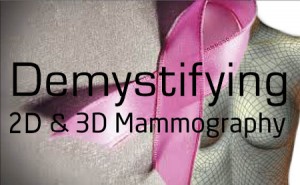Every year over 200,000 women in the U.S. are diagnosed with breast cancer, and every year breast cancer that has spread from the breast to other parts of the body (“late stage” or “metastatic” breast cancer) kills about 40,000 women. When breast cancer is detected early—before it has spread—it is easier to treat and women have a much better chance of surviving breast cancer. For now, mammograms are the best way of screening women for breast cancer.
In the United States, tomosynthesis – another name for 3D mammography – has been available in leading breast care centers since 2011. The FDA originally approved 3D mammography to be used in conjunction with 2D (digital) mammograms for breast cancer screenings. However, the agency determined last year that a 3D mammography system is now accurate enough to be used as a standalone test.

3D mammography generates images of the breast using technology similar to CT scans. Unlike 2D digital or film mammograms – which compress the breast and take images from only the front and side – a 3D imager takes multiple X-rays while moving across the breast in an arch. A computer then compiles the X-rays into a 3D reconstruction of the breast that can be analyzed by a radiologist. It takes just a few seconds longer than 2D mammograms, so the amount of radiation exposure is about the same. Patients generally experience no difference in the level of physical discomfort between 2D and 3D mammograms.
3D mammography has been a significant breakthrough in digital medical imaging. Unlike 2D mammograms that can obscure some cancers due to compressing and overlapping breast tissue, 3D mammography enables digital medical imaging specialists to examine breast tissue a layer at a time. A 3D mammogram is up to 40 percent more sensitive than digital or film mammograms, which means it can give doctors a clearer, more accurate picture of breast tissue and abnormalities.
3D mammograms can also be especially helpful for women with dense breast tissue as it’s more difficult to identify cancer in dense breasts. On a regular 2D mammogram, cancer and dense tissue appear almost the same, while a 3D mammogram can make better distinctions between the two.
The Center for Diagnostic Imaging is proud to provide patients and referring doctors with a comprehensive breast care center that has one of the only 3D mammography machines in the Miami area. We encourage all women to speak with their doctors right away if they experience any symptoms or suspect they are at high risk for breast cancer. Digital medical imaging plays an important role in the early detection and treatment of breast cancer.





